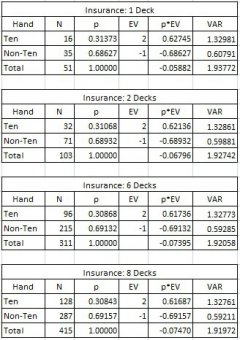Blackjack insurance rules

One of the original blackjack side bets is the Insurance wager. This side bet pays 2-to-1 whenever the dealer’s hole card is a ten-valued card, otherwise it loses. This side bet is clearly countable by keeping track of the number of ten-valued cards relative to non-ten-valued cards. The only reason it has not been crushed by APs is because of two limitations on this wager. First, it can only be made when the dealer shows an Ace up, so that the player only has the opportunity to make this side bet once per 13 hands on average. Second, the Insurance wager size is limited to one-half of the player’s main blackjack wager. Without these two limitations, the “ten-in-the-hole” side bet would have long ago been abandoned.
The house edge for Insurance is easy to compute. For example, in a single deck game, there are 16 face cards and 35 non-face cards (the Ace is already exposed). It follows that the true odds for Insurance are 35-to-16, while it pays 32-to-16. The edge on the Insurance bet is then 3/51, or 5.8824%. This is a fairly high house edge, hence the admonition to “never take Insurance.”
The following table gives the house edge and variance on Insurance for various numbers of decks:

Many gamblers and industry insiders alike don’t understand that Insurance is not part of the main game of blackjack. There is no rule that says this side bet must be offered. While almost no one makes this side bet, once per 13 hands the dealer has to ask the table for Insurance. If this takes 10 seconds (as the dealer waives her hand back and forth over the table), and the game is moving at 78 rounds per hour, then a full minute is consumed per hour with no benefit to the casino. That amounts to a loss of 1/60 = 1.67% of the total action at the table, and a corresponding incremental loss in revenue and decrease in hold. From a time and motion perspective, Insurance doesn’t protect against disasters; Insurance is a disaster.
In addition to the time and motion issues Insurance has, the real estate lost to this side bet is tremendous. Typically, side bets are offered in a small circle next to the player’s main wagering area. However, Insurance usually appears on the layout like this:
Imagine the artwork or other wagering opportunities that could replace a banner that advertises a side bet that wastes time and is barely utilized. For example, the casino could advertise a restaurant or a show in this space.
To see that Insurance is susceptible to card counting, consider an AP playing single deck blackjack. On the first hand after the shuffle, suppose that the AP looks at his cards and those of one neighbor and sees only non-ten-valued cards. Then there are 31 non-ten-valued cards remaining in the deck, so that the odds of winning the Insurance bet are 31-to-16. Voila! The AP has an edge of 1/47 = 2.1277%.
Elimination Blackjack is a tournament format of blackjack invented by Russ Hamilton, and is played on the Ultimate Blackjack Tour and in various casinos. It combines the game of blackjack with elements of No Limit Texas Hold'Em. Unlike Texas Hold'Em tournaments, players are still competing against the same dealer that is why the results of most...

